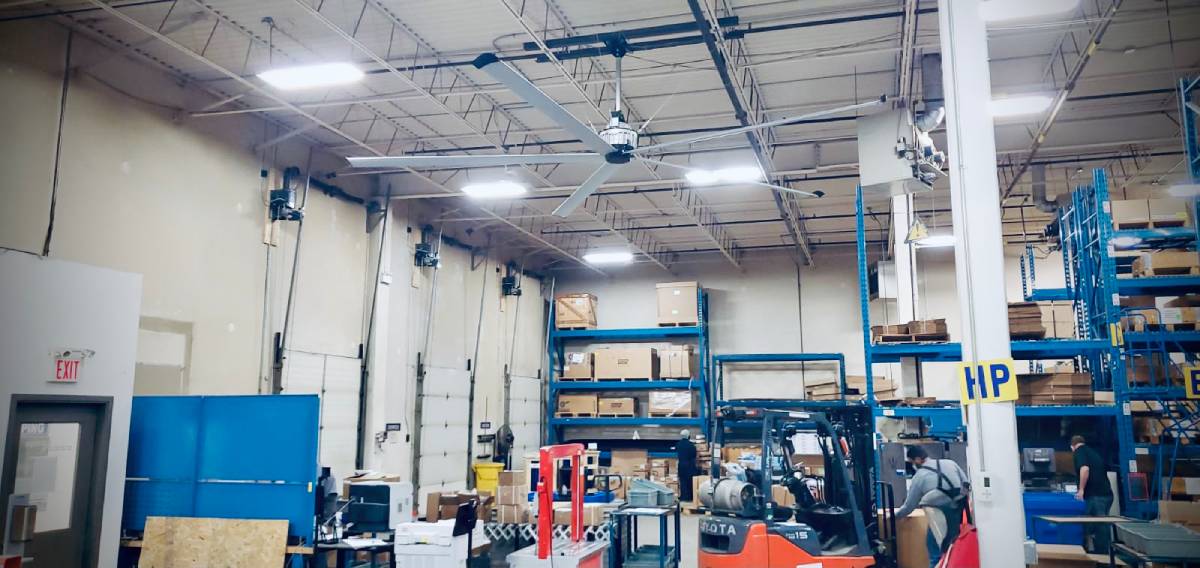
Poor humidity control in warehouse environments can significantly impact product quality and operational efficiency. Excess moisture not only creates uncomfortable working conditions but also contributes to metal corrosion, product degradation, and structural damage. Implementing strategic high-volume, low-speed (HVLS) fans offers an energy-efficient solution to enhance air circulation and maintain optimal humidity levels throughout the facility.
Understanding the Humidity Challenge in Warehouses
Warehouses are particularly susceptible to humidity issues for several reasons. Large spaces with high ceilings tend to trap warm, moist air, creating ideal conditions for condensation. The problem worsens in facilities that:
- Store moisture-sensitive inventory
- Have frequent door openings that allow outside air infiltration
- Are located in naturally humid climates
- Experience significant temperature fluctuations
- House processes that generate moisture
For warehouse managers, rust goes beyond typical appearance problems because they understand its progressively damaging effects. Rust actively shortens equipment lifespans while also contaminating products and causing both repair expenses and product replacement needs to grow.
The Science of Humidity, Air Movement, and Rust Prevention
When iron and steel materials experience oxidation, they create rust because they come into contact with either oxygen or water vapour. Oxygen cannot be removed from the chemical equation, but moisture control is achievable through air circulation methods, which prove essential for prevention.
Effective air movement addresses humidity problems through several mechanisms:
-
Evaporation Enhancement
When air moves across damp surfaces, it accelerates evaporation by carrying away water molecules. This principle is similar to how wind helps dry clothes on a clothesline. In warehouse settings, continuous air movement prevents moisture from settling on surfaces long enough to initiate the oxidation process that leads to rust.
-
Temperature Equalization
The storage environment of warehouses produces localized areas where temperatures differ from one section to another. Dew point problems arise specifically from the development of cold spots, which lead water vapour to condense on surfaces. Large-diameter ceiling fans mix air in a facility, creating consistent conditions and stopping condensation from occurring.
-
Dew Point Management
When the atmosphere reaches saturation level with water vapour, it turns into a liquid form that is known as the dew point. Fans produce moving air, which maintains a uniform temperature zone above the dew point, thus inhibiting moisture condensation on machinery, along with inventory and building structures.
Strategic Implementation of Warehouse Fans for Humidity Control
Simply installing fans isn’t enough—strategic placement and operational approaches maximize humidity control benefits:
1. Comprehensive Coverage Approach
To effectively manage humidity throughout a warehouse, air circulation should reach all areas, particularly:
- Areas with limited natural airflow
- Corners and dead spaces where stagnant air collects
- Spaces adjacent to loading docks or frequently opened doors
- Near equipment that generates heat or moisture
- Storage zones containing moisture-sensitive materials
HVLS fans are ideal for warehouses that excel in this application due to their ability to move large volumes of air efficiently. A single well-placed HVLS fan can replace numerous small fans while providing more uniform coverage and using significantly less energy.
2. Seasonal Adaptation Strategies
Smart warehouse managers adjust their fan usage based on seasonal needs:
-
Winter Operation:
The process of stratification becomes especially critical when winter arrives because the heated air rises until it reaches ceiling height, while the cooler air stays near the floor. HVLS fans operated at low speeds can deliver warm air downward in a non-drafty manner. When HVLS fans redistribute room temperature air throughout the space, they protect an even climate control environment that prevents freezing condensation during outdoor material transport.
-
Summer Operation:
Higher fan speeds create cooling effects through evaporation of perspiration, allowing for higher thermostat settings while maintaining comfort. This circulation also prevents humid air from stagnating against cooler surfaces, reducing condensation potential.
Measurable Benefits Beyond Rust Prevention
Well-implemented warehouse fan systems deliver multiple benefits that contribute to the return on investment:
Energy Efficiency Improvements
The U.S. Department of Energy estimates that properly installed HVLS fans can reduce heating costs by up to 30% through destratification. During summer months, the cooling effect allows for thermostat adjustments that can reduce air conditioning costs by 15-25%.
Extended Equipment Lifespan
Reducing moisture-related corrosion can significantly extend the useful life of:
- Forklifts and material handling equipment
- Racking systems and structural components
- Tools and maintenance equipment
- Electrical systems and control panels
Enhanced Product Integrity
Various products exhibit sensitivity to moisture exposure. The quality of paper goods, cardboard packaging, wood products, electronics, textiles and particular agricultural products deteriorates due to extreme humidity levels. The storage quality for delicate items remains optimal when there is continuous ventilation throughout the space.
Improved Air Quality
The constant flow of air through storage areas serves as a tool to break down airborne contaminants while scattering both fumes and odour molecules. A constant flow of air provides a better working space that decreases workplace respiratory problems in warehouse staff.
Implementation Considerations
When incorporating warehouse fans for humidity control, several factors should influence warehouse fans selection and placement:
-
Ceiling Height and Structure:
Higher ceilings generally require larger diameter fans for effective circulation to floor level.
-
Obstructions:
Racking layouts, overhead cranes, and lighting must be considered when positioning fans for optimal airflow.
-
Activity Zones:
Areas with high personnel activity or moisture-generating processes may need concentrated circulation.
-
Integration with HVAC:
Fan systems should complement existing heating, ventilation, and air conditioning systems rather than work against them.
Conclusion
The strategic implementation of air circulation leads to a wise investment choice for warehouses targeting the protection of inventory alongside facility maintenance and operational efficiency. Maintaining the correct relationship between air flow and moisture control will enable facility managers to extend equipment life duration and decrease maintenance expenses.
For warehouses looking to implement advanced air circulation solutions, Refresh Fans combines design elegance with engineering specifically calibrated for North American climate challenges. Our HVLS fan systems deliver the perfect balance of powerful performance and energy efficiency, backed by installation expertise that ensures optimal placement for your specific facility requirements.